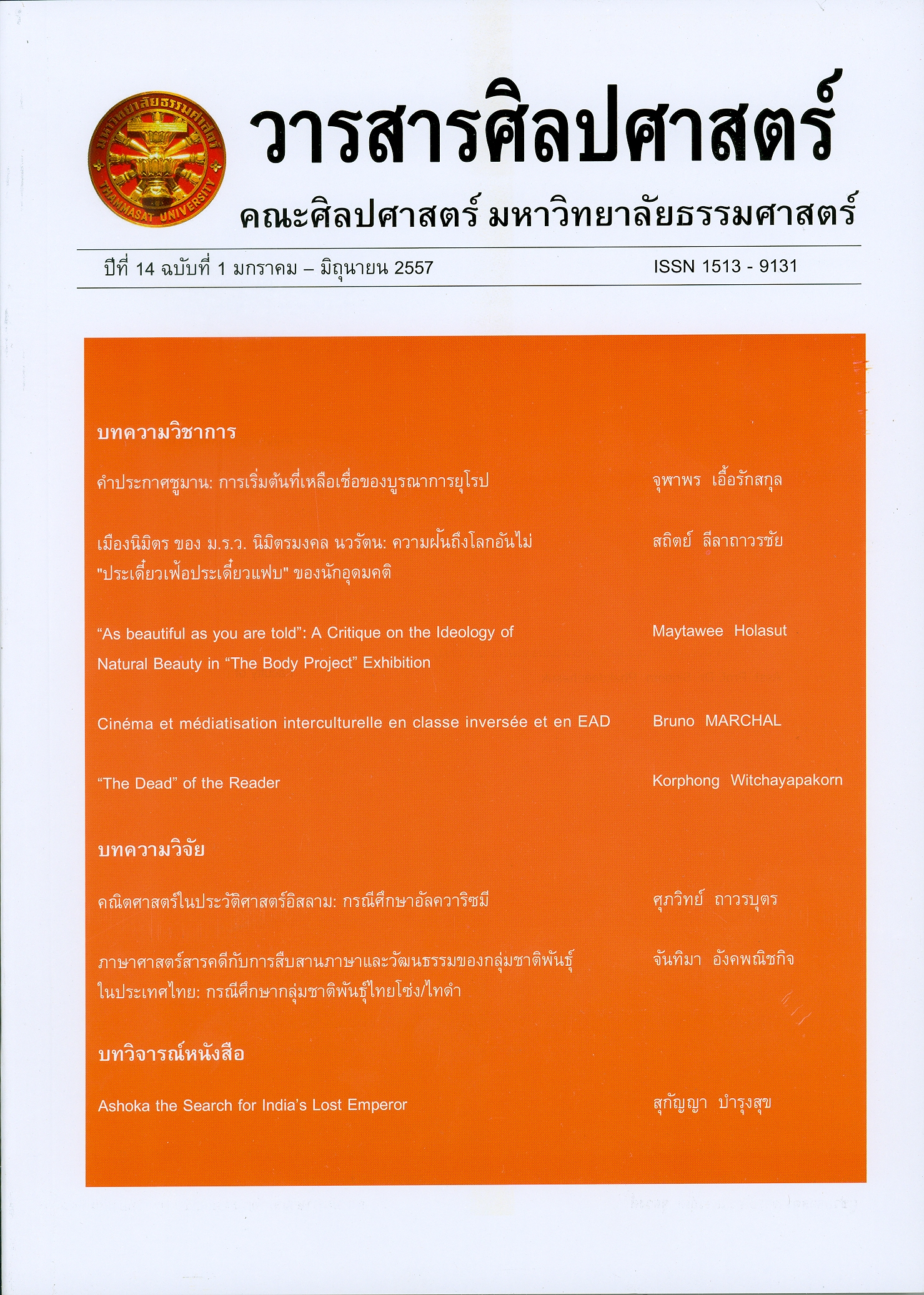ภาษาศาสตร์สารคดีกับการสืบสานภาษาและวัฒนธรรม ของกลุ่มชาติพันธ์ุในประเทศไทย: กรณีศึกษากลุ่มชาติพันธ์ุไทยโซ่ง/ไทดำ
Main Article Content
บทคัดย่อ
ภาษาศาสตร์สารคดีเป็นสาขาย่อยหนึ่งของภาษาศาสตร์ เป็นแนวทาง
เชิง สหวิทยาการในการศึกษาภาษาและวัฒนธรรมที่ตระหนักถึงความร่วมมือกับชุมชน
โดยเฉพาะชนกลุ่มน้อยและชุมชนภาษาที่อยู่ในภาวะใกล้สูญ (Himmelmann, 2006) แนวทาง
นี้เน้นการเก็บข้อมูลภาคสนามและพยายามที่จะเชื่อมโยงระหว่างภาษาศาสตร์เชิงพรรณนา
กับสาขาอื่น ๆ ที่เกี่ยวข้องกับภาษา เช่น สังคมวิทยา มานุษยวิทยา และวาทกรรมวิเคราะห์
เชิงวิพากษ์ วิถีปฏิบัติของแนวทางนี้เรียกกว่า กิจกรรมสารคดี (documentary activity) ส่วน
ผลผลิตที่ได้ เรียกว่า การจัดการข้อมูลตัวบท (language documentation)
บทความนี้เป็นบทความมาจากงานวิจัย มีวัตถุประสงค์เพื่อนำ เสนอแนวคิด
ภาษาศาสตร์สารคดี และให้ข้อเสนอแนะวิธีการศึกษาตามแนวทางวาทกรรมวิเคราะห์เชิง
ชาติพันธุ์วรรณนา ในการศึกษาภาษาและวัฒนธรรมที่ใช้ในการสร้างและดำรงอัตลักษณ์
ชาติพันธุ์ โดยเลือกชาติพันธุ์ไทยโซ่ง/ไทดำเป็นกรณีศึกษา การเก็บรวบรวมข้อมูลเชิง
ชาติพันธุ์วรรณนาและข้อมูลทางภาษาได้มาจากการศึกษาภาคสนามในชุมชนชาติพันธุ์
ไทยโซ่ง/ไทดำ 3 ชุมชนในจังหวัดนครปฐม ได้แก่ ชุมชนบ้านไผ่หูช้าง ชุมชนบ้านหัวถนน
และชุมชนบ้านเกาะแรตพัฒนา ในช่วงระหว่างเดือนมกราคม – มิถุนายน 2554 ผลการศึกษา
เบื้องต้นแสดงให้เห็นว่าคนไทยโซ่ง/ไทดำมีความพยายามที_จะสืบสานอัตลักษณ์ทาง
วัฒนธรรมของตน ไม่ว่าจะเป็นภาษาหรือเครื่องมือทางวัฒนธรรมภายใต้นโยบายการพัฒนา
ด้านการท่องเที่ยวและการธำรงรักษาภาษา อัตลักษณ์ชาติพันธุ์ไทยโซ่ง/ไทดำของคนรุ่นเก่า
และคนรุ่นใหม่กำลังถูกท้าทาย บทความนี้ยังชี้ให้เห็นว่าภาษาและวัฒนธรรมของชาติพันธุ์
ไทยโซ่ง/ไทดำในประเทศไทยกำลังปรับเปลี่ยน ปะปน และหลากหลายมากกว่าที่จะเป็น
เอกภาพ ภาษาที่ใช้และวิถีชีวิตที่ดำเนินไป มีลักษณะของการแข่งขันและต่อรองเพื่อนำไปสู่
การสร้างอัตลักษณ์ชาติพันธุ์ไทยโซ่ง/ไทดำในคนรุ่นใหม่ที่ต่างไปจากเดิม การศึกษาเชิง
ภาษาศาสตร์สารคดีด้วยวิธีการทางชาติพันธุ์วรรณนาน่าจะเป็นหนทางหนึ่งที่ช่วยให้เข้าใจ
สถานการณ์ทางภาษาและวัฒนธรรมของกลุ่มชาติพันธุ์ได้ดี
Documentary linguistics is a recently subfield of linguistics. It is a
multidisciplinary approach for studying language and culture that aims for cooperation
with the community of minority and endangered language speakers (Himmelmann,
2006). This approach promotes the collection of language field data and tries to link
mainstream descriptive linguistics to other language - related disciplines such as
sociology, anthropology, and critical discourse analysis. The main practice of this
approach is called documentary activity, and its product is known as language
documentation.
This research paper aims to introduce documentary linguistics and
ethnographic discourse analysis in order to study how language and cultural artifacts
are combined together in order to present and construct ethnic identity using
Tai Song/Tai Dam as an example. Ethnographic descriptions and language materials
in this paper are derived from field work among three Tai Song/Tai Dam communities,
which are Phai Hu Chang, Hua Thanon, and Koh Rat Pattana, of Nakornpathom
province during January to June, 2011. The analysis shows that Tai Song/Tai Dam
people have attempted to preserve their cultural identity, including their own language
as well as their cultural artifacts under the development policy for tourism and
endangered language revitalization. Also, they are challenging their ethnic identity
among younger and older generations. This paper argues that rather than assuming
that Tai Song/Tai Dam is a homogeneous linguistic and cultural situation,
Tai Song/Tai Dam language and culture is a dynamic, complex and diverse linguistic
situation. Their language use and their culture are contested and negotiated in order
to construct a modern Tai Song/Tai Dam identity among the younger generation of
Tai song/Tai Dam. As such this example illustrates how documentary linguistics can
make a contribution to the advocacy for the maintenance and revitalization of ethnic
minority languages and cultures.

